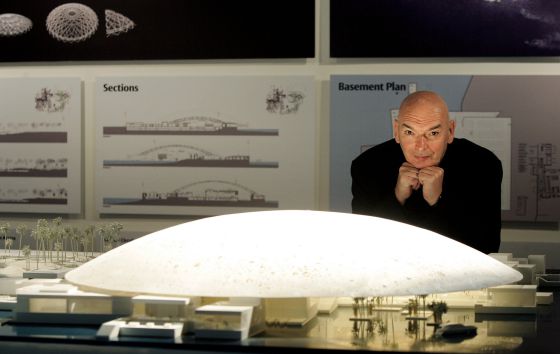
Jean Nouvel, ante el proyecto del Louvre Abu
Dhabi. / thomas coex (afp)
The Louvre Abu Dhabi is ready, two and a half years after its inauguration, to show the world the backbone of its permanent collection. In total, 130 objects from different places over the last four millennia in the exhibition Birth of a museum, which opens to the public on day 22 in the Saadiyat Island cultural district in Abu Dhabi. It is the first large-scale museum ambitious funds, the first with universal vocation of the Arab world and whose construction is based on a project by architect Jean Nouvel.
"The goal is to demonstrate the concept of universality making art objects dialogue of civilizations and eras," said Celine Hullo-Pouyat yesterday, director of the Louvre Abu Dhabi project during a previous visit to the exhibition. It is also, as stated during the presentation Emirati co-director, Hissa to Dhaheri, to "emphasize human values that unite us."
Hence, the sample is divided by civilizations and historical periods, but according to anthropological concepts. This statement of intent is apparent from the first room, which is dedicated to the representation of the human figure, a taboo for some radical interpretations of Islam. In it, the Conservatives opposed the sculpture of a Bactrian princess from the late third millennium BC (one of the jewels of the collection) and a Cypriot prehistoric idol with an abstract painting by Yves Klein. The effect is amazing and encourages reflection of the visitor. To help her, also have been placed screens on which video can be put into context mute that works and pieces linked to other museums.
"The mediation effort is part of the museum's educational objective," says Hullo-Pouyat. Like the rest of the exhibitions organized in Saadiyat, Birth of a museum will be accompanied by lectures, discussions and workshops. In addition, the Louvre Abu Dhabi seeks to establish permanent links with schools in the country and become an instrument of educational support.
The exhibition is divided into six trans-chronological rooms although not a literal illustration of the future museum itself evoke their aesthetic and narrative. In the dedicated to the Ancient World, The speaker, a Roman toga first century marble, is presented alongside a pedestrian statue of a Buddha, a piece dated between the second and third centuries. It is interesting to compare the similarities and differences in the folds of their cloaks or expression. A map explaining what was happening in the rest of the world at that time. Entitled The Sacred In a Jewish Pentateuch shares from Yemen cabinet with a diptych Christian and a Koran.
Later, the eastern Image contrasts with the western look, showing a score of paintings by some of the great European artists ranging from Murillo or Jordaens to Gauguin and Picasso. The presence in these works of Venus and nymphs in the bathroom, Jean-Jacques Lagrenée, whose protagonists are scantily clad, forced ago asking if conservatives found with red lines or warnings to local cultural sensitivity.
"No," he replies without hesitation Hullo-Pouyat. "We worked on a universal concept in the context of cultural and scientific program of the museum". Neither she nor the other makers reveal the total number of pieces in the collection or its value. And also refer to this program as a reference framework for the purchase of works by the Government of Abu Dhabi, the owner of both the museum and its contents. Having decided on the target must be aware of the parts that go on sale.
"This is the challenge facing all new museums because they can only access what is available in the market against centuries collections" admits Olivier Gabet, deputy conservation French Museums Agency, whose collaboration is the result of a bilateral agreement between Paris and Abu Dhabi. Gabet highlights the "exclusivity" not only of the works presented but how to present them.
For now, when it opens in late 2015, the museum also displays the permanent collection, funds borrowed from French museums. "As you increase the collection, loans will be reduced," explains the director. The organizers will be very attentive to how local audiences reacted to this exhibition, since the ultimate goal is that the museum will attract local and regional audiences, and that they get to call their own.
The announcement that the Emirate of Abu Dhabi signed an agreement with the Louvre to help him to develop his own art gallery and planned to build the largest Guggenheim in the world was met with skepticism when it was announced in early 2007. Three years after the financial crisis forced the makers to curb its ambitions. Only recently, work has resumed. Under the new timetable announced this year, the Louvre will open in two years, the National Museum signing Foster & Partners will be ready in 2016 and the Guggenheim, designed as one would expect by Frank Gehry opened in 2017. It also plans to build an auditorium designed by architect Zaha Hadid and a maritime museum by Tadao Ando draft.